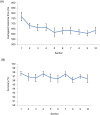A salient and task-irrelevant collinear structure hurts visual search
- PMID: 25909986
- PMCID: PMC4409306
- DOI: 10.1371/journal.pone.0124190
A salient and task-irrelevant collinear structure hurts visual search
Abstract
Salient distractors draw our attention spontaneously, even when we intentionally want to ignore them. When this occurs, the real targets close to or overlapping with the distractors benefit from attention capture and thus are detected and discriminated more quickly. However, a puzzling opposite effect was observed in a search display with a column of vertical collinear bars presented as a task-irrelevant distractor [6]. In this case, it was harder to discriminate the targets overlapping with the salient distractor. Here we examined whether this effect originated from factors known to modulate attentional capture: (a) low probability-the probability occurrence of target location at the collinear column was much less (14%) than the rest of the display (86%), and observers might strategically direct their attention away from the collinear distractor; (b) attentional control setting-the distractor and target task interfered with each other because they shared the same continuity set in attentional task; and/or (c) lack of time to establish the optional strategy. We tested these hypotheses by (a) increasing to 60% the trials in which targets overlapped with the same collinear distractor columns, (b) replacing the target task to be connectivity-irrelevant (i.e., luminance discrimination), and (c) having our observers practice the same search task for 10 days. Our results speak against all these hypotheses and lead us to conclude that a collinear distractor impairs search at a level that is unaffected by probabilistic information, attentional setting, and learning.
Conflict of interest statement
Figures








References
-
- Turatto M, Galfano G. Color, form and luminance capture attention in visual search. Vision Res. 2000; 40, 1639–1643. - PubMed
-
- Jonides J, Yantis S. Uniqueness of abrupt visual onset in capturing attention. Percept Psychophys. 1988; 43, 346–354. - PubMed
-
- Turatto M, Galfano G. Attentional capture by color without any relevant attentional set. Percept Psychophys. 2001; 63, 286–297. - PubMed
-
- Yantis S, Jonides J. Abrupt visual onsets and selective attention: evidence from visual search. J Exp Psychol Human. 1984; 10, 601–621. - PubMed
Publication types
MeSH terms
LinkOut - more resources
Full Text Sources
Other Literature Sources

